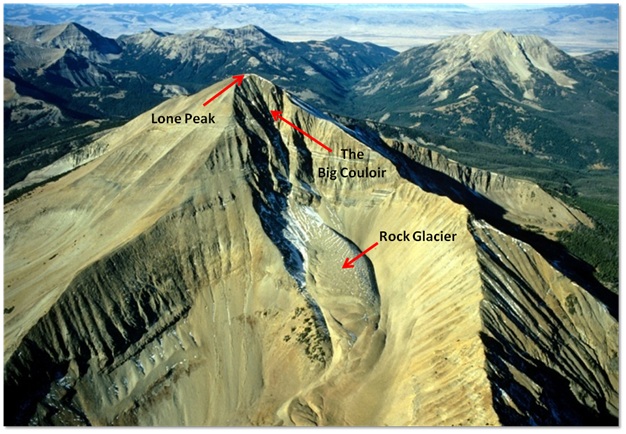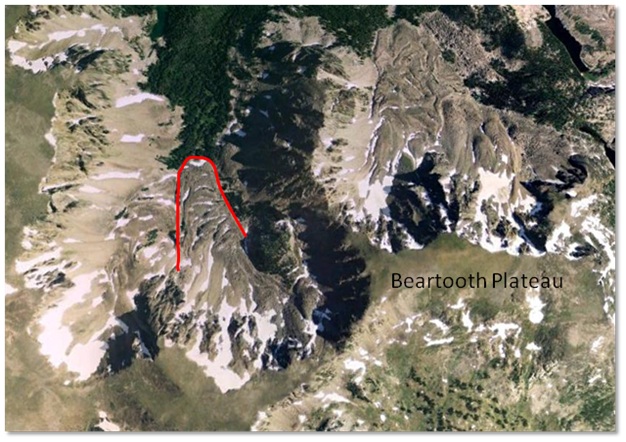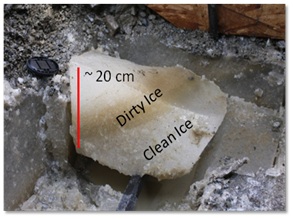|
Lone Peak Rock Glacier at Big Sky, Montana
 I thought glaciers were made of ice . . . I thought glaciers were made of ice . . .
If glaciers can be described as rivers of ice, then rock glaciers can be described as rivers of rock and ice. They can be spotted in relatively arid (dry) alpine (mountainous) environments as steep-edged, tongue-shaped, talus-mantled lobes coming off the slopes of valley walls or peaks. Rock glaciers have steep edges because there is ice inside them, holding all the rocks in place at an angle that is steeper than would otherwise be natural for a pile of rocks. This ice inside of rock glaciers can either be a solid core that perhaps was a glacier back before it was buried in rock (diagram), or it can be frozen between rocks as a sort of glue that formed as rain water and snow melt ran between rocks and then refroze.
Right: The Lone Peak Rock Glacier located on Big Sky Resort property in southcentral Montana (Aerial photo by Dave Lageson, late 1980s prior to tram construction).
They're everywhere . . .
Rock glaciers have been studied in mountain ranges on almost every continent, and they are especially abundant in southcentral Montana (SEE MAP). They are likely to be found wherever there are steep slopes, cold temperatures in the winter, and a supply of rocky material (known as talus). Scientists think that rock glacier development and persistence is dependent on what size of talus is available, but that hypothesis is still being tested. The hypothesis states that there is a "sweet spot" for talus. Talus covering a rock glacier can act as a blanket that traps cold air and keeps the ice beneath cold. Talus that is too small will not provide enough space between rocks for cold air to flow. Talus that is too large will provide too much space between rocks and so cold air will escape.
Skiing the rock glacier gnar . . .
The Lone Peak rock glacier (LPRG) is located on Big Sky Resort property, directly beneath the bottom lift station of the famed Lone Peak tram. The tram runs to the top of Lone Peak at 11,166 ft (3399 m). See if you can find the tram in this photo. Skiers coming down from "The Big Couloir" and other runs accessible via the tram will ski over a large mound, affectionately known to locals as "the Cueball." The Cueball is actually a rock glacier that is probably thousands of years old. Samples of ice were taken from the LPRG in the summer of 2009. The ice at LPRG is inside the rock glacier, though, so sampling involved excavation of ~3 m (~ 9 ft) of talus and use of a mini-Bobcat excavator. Once removed it became clear that this thick blanket of rock was doing its job; a continuous layer of ice was encountered at a depth of ~ 3 m. The layer of ice was then sampled using a chainsaw. Ice blocks ~ 20 cm x 20 cm were recovered. Under the layer of ice was a layer of ice and rock frozen together. The insides of a rock glacier are complicated and do not consist of only one material (ice) or another (rock).
 Wrinkling like a rug . . . Wrinkling like a rug . . .
Just like glaciers, rock glaciers move! Most rock glaciers have average surface velocities of a few tens of centimeters per year. The LPRG is no exception. Since the bottom lift station of the tram was built on the rock glacier in 1995, its movement has been closely monitored. As they flow downhill, many rock glaciers exhibit a wrinkly surface that looks like a rug that has been crumpled. These wrinkles are technically referred to as ridge and trough topography, and seem to be related to the movement of the rock glacier. It is thought that the wrinkles represent faults within the rock glacier. In other words, as the rock glacier moves downhill it gets caught up on itself. Just like tiles overlapping on a roof, or wrinkles on a rug, segments of the rock glacier start to overlap each other.
Right: There are actually a few rock glaciers in this Google Earth image. One is outlined. Can you identify any others? HINT: Rock glaciers are steep-edged, tongue-shaped, talus-mantled lobes coming off valley walls or peaks. Here is another rock glacier (Google Earth image) near Beartooth Mountain.
Life in the ice . . .
Geoscientists have taken ice samples from the bottom of glaciers in Antarctica and the Canadian Yukon and studied them for their microbiological content. These ice samples tend to be pretty dirty; that is, they contain a lot of particulate rock debris. The results of these studies show that microbes are associated with debris; that is they prefer to hang out in ice that has rock particles in it rather than ice that is clean, i.e. no rock particles are present. Certain microbes can use rock debris as food; their metabolic processes depend merely on having a carbon source and an electron acceptor available. Microbes can use rock debris to serve these purposes and are quite happy in an environment as seemingly unfriendly as the bottom of a glacier where it can be very dark and very cold. According to these findings, it seemed to follow that rock glaciers would be happy environments for microbes that can live in icy environments where rock debris is present. Microbiological experiments performed on ice samples taken from the LPRG show that indeed, microbes are present in higher concentrations in ice samples with particulate rock debris.  . . . . . . 
Caitlyn Florentine, M.S. who conducted her thesis research on the Lone Peak rock glacier, gives the ice surface a big smooch. The mini-bobcat excavator used for uncovering the ice surface pictured in the background. A chainsaw was used to produce this ice block, used for microbiological and geochemical experiments. Thanks to Caitlyn for contributing the content (images and explanations) on this page!
Term: talus
| 

 . . .
. . . 



